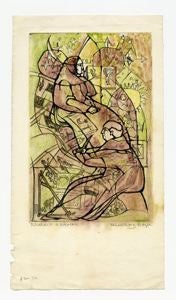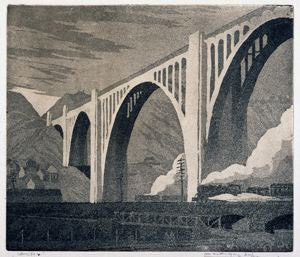An exhibition of fine prints for the opening of the fall term 1987.
Introduction
The history of American graphic art of the 20th century is incomplete without recognition of the work of the Boyer family of Pittsburgh – the husband, Ernest Wilson Boyer (1884-1949), his wife Louise Miller Boyer (1890-1976), and their daughter Helen King Boyer, born in 1919.
Both parents graduated from Pittsburgh’s Carnegie Institute of Technology in 1913, he in architecture and she in painting and design. They were married the following year. Ernest, known to his friends as Arch, became one of Pittsburgh’s finest architects as well as a printmaker of distinction. During the depths of the depression, he returned to Carnegie Tech, studying printmaking and experimenting with innovative technique in etching such as the use of a lithographic pencil stopout.
Printmaking for Arch and Louise was a lifelong family adventure. In 1918 they purchased a huge antique etching press made in the late 1600’s. The earliest memories of their daughter Helen are of her parents working at that bulky hand-turned press. With the encouragement and training of her mother, Helen began to draw at age 5, and by the time she was 12 she was exhibiting prints with her parents. Later she would attend technical classes at Carnegie Tech.
In the early 1930’s Louise began experimenting with anodized aluminum plates, an interest in which Helen became deeply involved. The copper and zinc etching plates on which they had been working had to be coated with an acid-proof varnish, or ground. The lines of the image were then cut through the ground to expose the metal to the biting action of an acid bath. The process, slow and painstaking, required the controlled environment of the studio. The anodized aluminum plate, on the other hand, allowed the artist to bypass the grounding and acid biting procedures. Only a needle (i.e., a “dry point”) was needed to cut a design into the plate.
Louise soon discovered that the aluminum accepted a wide variety of tones, brisk to delicate, with the normal pressure of the hand. It was also ideal for either field sketching or studio use. Louise would later perfect the aluminum plate as a printmaking medium while serving as an advisor to ALCOA. It is this experimental work of Louise and Helen Boyer that has become a valuable and permanent contribution to the history of 20th century American printmaking.
In 1932 Louise started work on her monumental “Pittsburgh Series” of twenty-two aluminum drypoints, a record of industrial life along the banks of Pittsburgh’s Monongahela River – its mills, its laborers, and their houses desperately clinging to the surrounding hillsides. Fifteen of these classic examples of urban regionalism are to be found in this exhibition. Also included is Arch’s Bridges, perhaps his finest aquatint, done in 1933. By the time he died in 1949, he, as well as his wife and daughter, were honored members of the Society of American Graphic Artists and had won prizes in major American print annuals throughout the country.
The Boyer women continued to create aluminum drypoints, Louise until her death in 1976, and Helen to this day, although her prints since World War II include a few wood engravings, woodcuts, and aquatints. Georgetown’s collection of their aluminum drypoints is probably the finest in existence, rivalled only by that of the Smithsonian’s National Museum of American History, where many of their aluminum drypoint plates are now preserved.
Both women are also represented in the print collections of the Library of Congress, the Metropolitan Museum of Art in New York, the Carnegie Institute in Pittsburgh, and the Nelson-Adkins Museum in Kansas City, among others.
Catalog
This exhibition of fifty-three prints, printing plates and drawings by members of the Boyer family is drawn from over 200 works donated to Georgetown by Helen King Boyer in memory of her parents. It represents a span of seventy years of printmaking by this extraordinary family of artists.
In addition, the exhibition features selections from the Boyer family archives, which comprise some seven linear feet of correspondence, manuscripts, photographs, drawings, and related items. Among the earliest family records are letters by controversial politician and Boyer kinsman Nathaniel Boileau, Secretary of the Commonwealth of Pennsylvania during the War of 1812.
Much of the Boyer archive consists of papers of Louise’s father, Zachariah Taylor Miller (1847-1913), Civil War veteran and professor of homeopathic medicine at Carnegie Tech. Besides a striking series of 131 Civil War letters from Dr. Miller to his family, the archive includes more than 250 letters by his sister-in-law, pianist Julie Rive-King, a renowned American virtuoso of the last quarter of the 19th century. There are also numerous letters from Dr. Miller’s close friend John Alfred Brashear (1840-1920), noted scientist and maker of astronomical lenses, of whom Louise Boyer made on of her most delicate drypoints. Both of Louise’s parents took a lively interest in art. Dr. Miller was a competent artist, as evidenced by his sketch of his mother, and his wife, Katherine King Miller (1849-1909), spent summer vacations hand-illuminating books at Elbert Hubbard’s Roycroft Press.
Works are listed alphabetically by artist and title. Dimensions giving image size (plate and composition) are given in centimeters, height preceding width.
Ernest Wilson Boyer (1884-1949)
[Bakery Truck] c. 1925
Aquatint
10.6 x 7.4
Blast Furnace, c. 1916
Etching
24.7 x 14.5
Bridges, 1933
[The Westinghouse Bridge, Pittsburgh]
Aquatint ed. 50
20. x 23.7
Cliff Dwellers, c. 1934
Etching
22.5 x 12.0
[Dawn] 1934
From his Miniature Suite
etching
2.2 x 2.5
[Dusk] 1934
From his Miniature Suite
etching
2.2 x 2.5
Façade of Sacred Heart Church, 1933
Etching, ed. 15
30.0 x 21.3
Gambrels, 1939
Etching
16.3 x 24.8
Hay Mows, 1931
Pencil drawing
12.9 x 15.1
Hay Mows, 1931
Etched copper plate
12.9 x 15.1
Hay Mows, 1931
Etching, posthumous ed. of 50
12.9 x 15.1
Poplars, 1934
Soft ground and lithographic pencil stopout
7.5 x 10.5
[Trees and Fields] c. 1931
Etching
6.4 x 10.7
[Wintry Road] 1933
Etching
6.6 x 10.0

Helen King Boyer (b. 1919)
Abelard and Heloise, 1952
Drypoint, ed. 50
21.2 x 13.7
Adoration of the Lamb, c. 1945
Drypoint, ed. 50
18.5 x 22.5
“…and there was Light.” 1960 [Genesis 1, 3]
Aquatint, unique proof
18.5 x 15.9
East of the Sun, 1980
Color drypoint, ed. 50
21.2 x 26.5
Edge of Perdition: the Intercessor, 1982
Woodcut, ed. 100
30.3 x 25.5
The Iconoplast, 1960
Etching and aquatint
23.6 x 20.2
Mortal Tears, 1977
Color aquatint, ed. 25
20.9 x 15.0
The Odalisque, 1950
[reflections in a brass doorknob]
Color drypoint, ed. 50
7.0 x 6.0
Peace Table #2, 1946
“For they shall rebuild the old wastes…and restore the ruined cities.” [Isaiah 61, 4]
Drypoint, ed. 50
18.8 x 21.4
PM, 1952
Color drypoint, ed. 50
2.7 x 5.3
Quiet Meeting, 1950
Drypoint, ed. 50
6.1 x 3.8
Rumor, c. 1943
Drypoint, artist’s proof
13.8 x 11.3
In America in the War exhibitions
Some Stars & Two Atoms, 1951
Drypoint, ed. 50
21.3 x 13.8
Temptation, 1950
Drypoint, artist’s proof II
21.3 x 13.8
[Victory Amid Trophies] Nude, 1941
Drypoint, state I, trial proof
30.2 x 19.9
Victory Amid Trophies, 1941
Drypoint, state III, four proofs
30.2 x 19.9
Witnesses, 1974
Color drypoint, ed. 50
10.0 x 7.5
Louise Miller Boyer (1890-1976)
Barges – Dravo Company, 1941
Pittsburgh Series, #14
Drypoint
13.8 x 21.4
Bipps at 17, 1933
[the artist’s son – used as Peer in her Peer Gynt Suite of 1936]
Drypoint
20.3 x 13.9
Buzzard’s Roost, 1953
[for the Miniature Print Society]
Drypoint
10.0 x 7.6
Buzzard’s Roost
Cancelled aluminum drypoint plate
10.0 x 7.6
The Converter at Night – I, 1934
Drypoint, ed. 120
13.7 x 11.2
The Converter at Night – I, 1934
Cancelled aluminum drypoint plate
13.7 x 11.2
The Converter at Night – II, c. 1940
Pittsburgh Series, #7
Drypoint, posthumous ed. of 25
21.3 x 13.8
Crenellated Hill, 1940
Pittsburgh Series, #9
[for the Society of Print Connoisseurs]
Drypoint
23.0 x 26.7
Daily Dozen – state II, c. 1941
Pittsburgh Series, #19
Drypoint
26.3 x 21.4
Eight Bridges and a Curved Incline, c. 1935
Pittsburgh Series, #5
[for the Society of American Print Collectors]
Drypoint
21.4 x 27.6
The Haves and Havenots, c. 1933
Pittsburgh Series, #2
Drypoint, ed. 25
26.2 x 24.1
[illus. in Reese, American Prize Prints of the Twentieth Century]
Helen at 14, 1934
[the artist’s daughter]
Drypoint
20.1 x 13.8
The Hot Mill: First Line of Defense, 1941
[Alcoa Works, New Kensington]
Pittsburgh Series, #15
Drypoint, ed. 100, 29 printed
21.3 x 13.9
In America in the War exhibitions
Incredible Cohesions, c. 1935
Pittsburgh Series, #6
Drypoint, ed. 5
21.5 x 13.8
John Brashear – small plate, c. 1939
Drypoint, ed. 25
10.0 x 7.5
The Mills Whence Comes Our Strength, 1941
Pittsburgh Series, #18
Drypoint
21.4 x 26.4
Monastery Hill, c. 1935
Pittsburgh Series, #3
Drypoint
32.3 x 36.6
Snow Shadows, 1936
Pittsburgh Series, #11
Drypoint
18.8 x 20.2
Snowshroud, 1932
Pittsburgh Series, #1
Drypoint, ed. 13
14.0 x 20.3
Steel Strike, 1935
Pittsburgh Series, #4
Drypoint, posthumous ed. of 25
21.3 x 13.8
Storm Over Steel, 1942
[The Mills at Aliquippa]
Pittsburgh Series, #21
Color drypoint
11.3 x 13.8
Winter on West Bellecrest, 1941
Pittsburgh Series, #12
Drypoint, posthumous ed. Of 25|
20.2 x 16.2

